Sistine Chapel in Vatican City, the historic, artistic and religious monument of the Renaissance, was built between 1475 and 1483, during the time of Rome papySiksta IV della Rovere.
First, look at a panorama of the chapel, and then offer more acquainted with the history and frescoes.
(Panorama opens in a new window on the left-vnmzu - control buttons)
History
First floor - the most powerful and durable. The second floor of the main, on the longitudinal side walls located on the six windows, two windows are on the front wall.
The third floor is a gallery guard around the building. Originally the gallery was open, and later erected a roof over it, because the water is flowed into the chapel.
The project was made by Bahco Pontelli, the construction of controlled Giovannino de Dolci.
15th August 1483 held its first worship service. (Feast of the Assumption of the Virgin
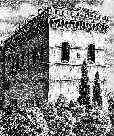 This is - the original form of the Sistine Chapel. More recent completion of the initial appearance changed. View from the north-west corner (same as above), before the addition of support on the long walls, roof, and before the altar wall of windows were closed, and raised a number of other buildings.
This is - the original form of the Sistine Chapel. More recent completion of the initial appearance changed. View from the north-west corner (same as above), before the addition of support on the long walls, roof, and before the altar wall of windows were closed, and raised a number of other buildings.Now Sistine Chapel, like a rectangular box and adjacent to the Cathedral of St. Peter, looks like a feudal structure.
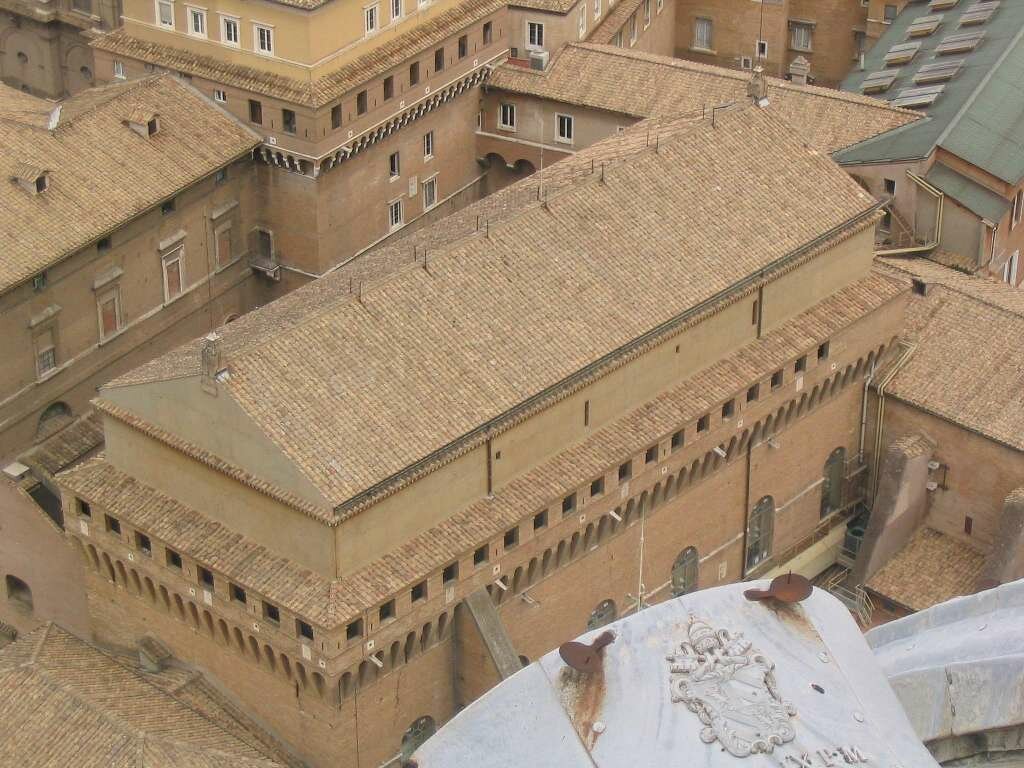
In 1481, after the convergence of the Pope and Lorenzo de 'Medici (two years after the Pazzi conspiracy) group of the best Florentine artists was invited to Rome, where, together with the Umbrian masters in 1481-83 years. adorned the walls of the Sistine Chapel. It was Sandro Botticelli, Pietro Perugino, Domenico Ghirlandaio and Cosimo Rosselli, with the participation of his assistants: Pinturicchio, Signorelli, Bartolomeo della Gatta, David Ghirlandaio, Piero di Cosimo, Biagio D'Antoni. These frescoes contain many portraits of figures (12 in the surviving frescoes there are at least hundreds). The original murals were 16, 12 survived.
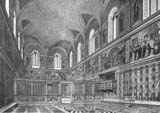 The frescoes were executed in a surprisingly short time, for 11 months, from July 1481 until May 1482. The ceiling was decorated with frescoes by Piero Matteo d'Emiliey - star-studded, sequined sky. This type was the Sistine Chapel in the days of Sixtus IV,
The frescoes were executed in a surprisingly short time, for 11 months, from July 1481 until May 1482. The ceiling was decorated with frescoes by Piero Matteo d'Emiliey - star-studded, sequined sky. This type was the Sistine Chapel in the days of Sixtus IV,
This chapel is better lit and can provide a better scope, walls, separated cornices and pilasters. You may notice a change in the location of the fence, later moved closer to the entrance to leave more room for "the papal chapel." The frescoes were executed in a surprisingly short time, for 11 months, from July 1481 until May 1482. The ceiling was decorated with frescoes by Piero Matteo d'Emiliey - star-studded, sequined sky. This type was the Sistine Chapel in the days of Sixtus IV,
The frescoes were executed in a surprisingly short time, for 11 months, from July 1481 until May 1482. The ceiling was decorated with frescoes by Piero Matteo d'Emiliey - star-studded, sequined sky. This type was the Sistine Chapel in the days of Sixtus IV,1508g in a new pope, Julius II Della Rovera, a nephew of Pope Sixtus IV, commissioned Michelangelo to paint the ceiling anew, work was completed between 1508 and 1512.
At 1535g Michelangelo on behalf of Pope Paul III Farnese, began to paint the altar wall of the Last Judgment scene. He graduated from the mural v1541g.
The building can be considered as a personal monument to the family of Della Rovera, as Sixtus IV began its construction, and continued - his nephew, Julius II. Oak leaves and acorns, heraldic symbols of the family Della Rovere, whose name means literally "from the oak," abound on the elements of the frescoes.
The frescoes have suffered from centuries of soot from candles. The fresco of the Last Judgment was painted over, even when Pope Pius IV, who seemed to insult the presence of nude figures in the scene of religious content.
The decoration of the chapel was cleaned and restored in recent decades. The project, which began with the frescoes of the fifteenth century - in 1965. Restoration of the arches and the Last Judgment scene, which began in 1980, was completed in 1994.
Of course, the five centuries have not been to the chapel without a trace, but the guard at the Vatican, a work of antiquity, and now you can see this gem of the Vatican in the form which it was created.
Since the end of the XV century, in the Chapel are the Conclave (the choice of a new pope). The first Conclave, held in the Chapel, was a conclave of 1492, which elected Alexander VI.
It serves as a chapel of the papal palace and place of electing a new pope after the death of the preceding.
120, specially appointed, bishops and archbishops are locked in the chapel, and do not leave it until they elect a new pope.
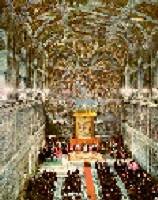
The faithful gathered in the square, find out about election results by the conventional smoke alarm: white smoke notify electing a new pope, black is - to continue voting.
Currently, the chapel is open to visitors as a museum, an outstanding monument of the Renaissance.
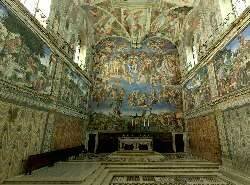
Комментариев нет:
Отправить комментарий